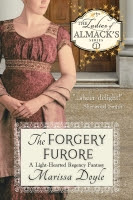 Now, here’s a holiday to make the most hardened heart go pitter patter. Valentine’s Day was highly celebrated during the nineteenth century. Any young lady or gentleman could send a valentine to a sweetheart, either delivered by hand or by penny post. These weren’t cards as we know them today, but sheets of regular writing paper about 9 by 12 inches. Earlier in the nineteenth century they were mostly white (or cream—whatever color the paper happened to be), with a drawing in the center and a few words of poetry penned around the drawing. Sometimes the words would be above and below the drawing, sometimes around the edges of the sheet. Like the clothes we’ve been discussing the last couple of weeks, the deeper you go into the century, the more elaborate the valentines became.
Now, here’s a holiday to make the most hardened heart go pitter patter. Valentine’s Day was highly celebrated during the nineteenth century. Any young lady or gentleman could send a valentine to a sweetheart, either delivered by hand or by penny post. These weren’t cards as we know them today, but sheets of regular writing paper about 9 by 12 inches. Earlier in the nineteenth century they were mostly white (or cream—whatever color the paper happened to be), with a drawing in the center and a few words of poetry penned around the drawing. Sometimes the words would be above and below the drawing, sometimes around the edges of the sheet. Like the clothes we’ve been discussing the last couple of weeks, the deeper you go into the century, the more elaborate the valentines became. An enterprising young lady could either make her own valentines or purchase them ready made. Many were hand-colored using colored pencils or water color paints. Flowers, doves, vines or trees, and hearts were common motifs. Another was the endless knot of love or True-Love Knot, something like what we call a Celtic knot, only words were written within the double lines, requiring the recipient to turn the valentine to read the sentiment.
The more artistic you were, the fancier the valentine. A few well-placed snips of the scissors and edges begin to look like basketwork. A few more, and you have silhouettes. The handwork was incredible. They also used pins to make tiny holes in sections of the paper to make it look embossed or bigger holes to make it look like lace.
 The most elaborate type of valentine was known as a puzzle purse. The general idea is very similar to the “fortune tellers” children make where you slip your fingers up inside folded paper and move them back and forth in time to a rhyme or counting, then lift up flaps to reveal the answer to your question. Our nineteenth century young ladies didn’t ask questions, but they had to figure out how the flaps unfolded to learn the actual message of the valentine. The trick was to uncover the center flap, because that’s where your admirer would have hidden a secret message to you (unbeknownst to your watchful governess and parents). The center fold was just large enough to hide a lock of hair, a love note, or some other small token of affection.
The most elaborate type of valentine was known as a puzzle purse. The general idea is very similar to the “fortune tellers” children make where you slip your fingers up inside folded paper and move them back and forth in time to a rhyme or counting, then lift up flaps to reveal the answer to your question. Our nineteenth century young ladies didn’t ask questions, but they had to figure out how the flaps unfolded to learn the actual message of the valentine. The trick was to uncover the center flap, because that’s where your admirer would have hidden a secret message to you (unbeknownst to your watchful governess and parents). The center fold was just large enough to hide a lock of hair, a love note, or some other small token of affection. Next Friday I’ll share some of the outrageous stunts pulled on Valentine’s Day. In the meantime, don’t forget that you have until Monday evening to guess Marissa’s mystery object and win an advance reading copy of her book, Bewitching Season. And if you just can’t wait to read more about the nineteenth century, you might want to drop by Belgrave House’s Regency Reads site, where another of my reissues is now on sale as an electronic book. The Bluestocking on His Knee tells the tale of charming fortune hunter Kevin Whattling’s quest to marry heiress Eugennia Welch, one of the most intelligent women in London. But will her disciplined mind overrule the dictates of her heart?





3 comments:
As usual, your research amazes me. I had no idea such a thing as puzzle purses existed, and in fact I didn't know Valentines were exchanged before the Victorian period.
I'll have to pop over and look at that site.
Thanks, Gillian! I have to say, though, that the research is one of the best parts of writing about historical periods. I feel like Brer Rabbit and the briar patch: "Oh, please don't make me do more research!" :-)
I'm so glad a handful of publishers continue to publish and re-issue true Regency titles...there's nothing like them for wit and fun. Especially Regina's.
Post a Comment